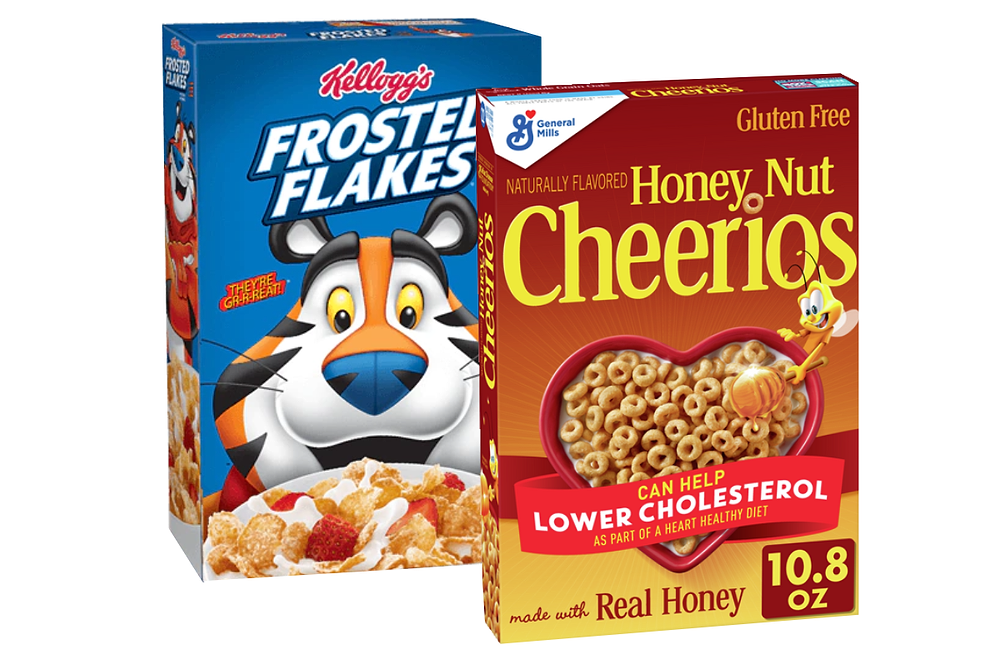NEW YORK — While 84% of consumers are concerned about the impact of inflation on their daily lives, most are willing to absorb rising prices when it comes to ready-to-eat cereal, according to new research from Veylinx, a New York-based consumer insights platform.
In “Pricing the cereal aisle: Understanding how consumers react to inflation,” Veylinx studied the impact of price increases on demand among 6,410 US consumers over the age of 18 for two of the most popular US cereal brands: Cheerios and Frosted Flakes. The study measured demand for five existing varieties of Cheerios (Cheerios, Cinnamon Cheerios, Fruity Cheerios, Multi-Grain Cheerios and Maple Cheerios) and five existing varieties of Frosted Flakes (Frosted Flakes, Honey Nut Frosted Flakes, Chocolate Frosted Flakes, Frosted Flakes with Cinnamon Basketballs and Mashups Frosted Flakes + Froot Loops) as well as four packaging innovations (sustainable packaging, mega-multi pack, single-serves and resealable bag).
According to the findings, relatively small price increases have little effect on demand for these breakfast staples.
For example, the study found that when prices rose by 20¢ (from $3.29 to $3.49), demand for Frosted Flakes was virtually unchanged and demand for Cheerios dropped by only 1.5%. Larger price increases do have a more significant effect on demand; a 50¢ price increase reduced demand for both brands by almost 13%, according to Veylinx.
The study also found that consumers who eat cereal more than twice a week were more tolerant of price increases. Veylinx said demand among those consumers fell by only 15% when the average price increased from $3.29 to $3.99 (a 21% increase). At this price change, demand dropped by 26% for people who consume two or fewer bowls per week, the study found.
The Veylinx study found $3.99 to be “an important psychological threshold,” with demand falling sharply above that price point. An additional drop-off in demand was noted at a $4.99 price point, the study found.
Breaking down the findings among consumers, men were nearly twice as willing to absorb price increases as women, the study showed. Meanwhile, older consumers (55+) expressed the most worry about inflation — with 89% somewhat or very concerned — but were just as likely to absorb price increases as younger consumers. Gen Z consumers were the least worried about inflation (only 71% concerned), which also was reflected in their greater willingness to tolerate rising cereal prices, the study said.
Approximately 78% of consumers with an annual income of less than $25,000 were worried about inflation, which compared with 88% of consumers with more than $100,000 in annual income who reported being somewhat or very concerned about inflation.
In addition to inflation, more than 60% of consumers said they worry about supply chain disruptions, the study found.
An additional finding enabled by Veylinx’s proprietary behavioral methodology revealed that consumers consistently overstate their interest and the amount they are willing to pay in traditional surveys versus real purchasing situations. For example, 76% of consumers said they would purchase Frosted Flakes in a resealable bag when surveyed, but when faced with an actual purchase decision, only 39% did.
“Consumer goods companies are under tremendous pressure to offset rising costs by raising prices,” said Anouar El Haji, chief executive officer of Veylinx. “However, they can’t rely on historical data or traditional methods to accurately predict what consumers are willing to pay. The current situation requires a new way of measuring demand for both existing products and innovations. This cereal study shows how important it is to use real behavioral insights to update prices and positioning while identifying which innovations to launch under these inflationary circumstances.”
The Veylinx study also looked at purchase interest for a variety of packaging innovations to see if they provide opportunities for brands to raise prices without reducing consumer demand. The study found most of the packaging innovations did not drive higher demand than the standard Cheerios and Frosted Flakes boxes, regardless of the price point. Sustainable packaging showed the most promise for Cheerios, performing the best at higher price points than the other innovations tested, Veylinx said, while single-serve pouches drove the greatest demand of those innovations for Frosted Flakes.
The study also analyzed why consumers choose Cheerios or Frosted Flakes. According to Veylinx, 44% of consumers choose Cheerios because they expect it to taste good, which compared with 59% who said they expect Frosted Flakes to taste good. Meanwhile, 47% said they choose Cheerios for its brand recognition, compared with 51% who choose Frosted Flakes. The gap widened when it came to health and wellness, with 39% of consumers saying they choose Cheerios because they believe it to be healthier than other products, which compared with 21% of consumers who choose Frosted Flakes for its health attributes.
Taking into account all RTE cereal brands, 18% of the 6,410 US consumers surveyed said Cheerios was the brand they purchased the most in the past six months, followed by Cinnamon Toast Crunch (13%), Frosted Flakes (11%), Special K (9%), Lucky Charms (8%), Froot Loops (8%) and Life (6%). The remaining 27% most often purchased an “other” brand during the past six months, the survey said.




